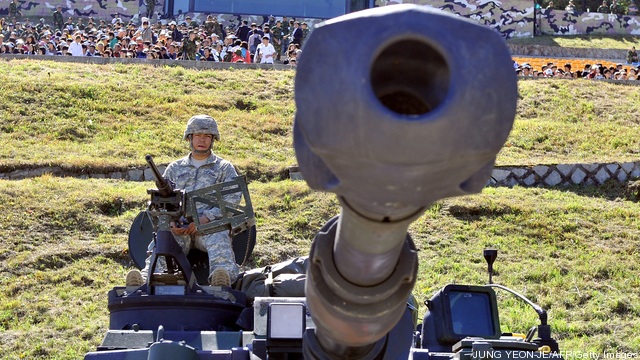Tank Goodness: Armor Programs Will Recover Despite GCV Kill, Sequester
Posted on

Sometimes dark clouds really do have silver linings. The winding down of two wars and the automatic spending cuts called sequestration have been brutal for the Army budget. The service recently had to cancel its top-priority weapons program, the tank-like Ground Combat Vehicle. But even if sequestration continues, said one leading analyst, ground vehicle spending has at the very least bottomed out — and it may well rebound impressively.
“Hey, there’s actually kind of a little growth profile, and actually a pretty robust growth profile if that plan can get achieved,” said Byron Callan, defense analyst at Capital Alpha Partners LLC. The budget the president submitted earlier this month — which relies on a politically unlikely roll-back of the sequester — would increase ground vehicle spending from $1.5 billion in 2015 to $5.5 billion in 2019. Realizing even a fraction of that planned growth would be great news for the Army and the industrial base.
In fact, the Ground Combat Vehicle’s cancellation may have been a blessing in disguise, because the Army sacrificed the controversial GCV to free up funds for other, more modest programs. As Callan put it to me this morning, “instead of the turkey, you’ve got a lot of sparrows, and maybe turkeys are easier to shoot at than sparrows.”
The Army no longer has one “big, iconic program” with the sort of big, iconic problems that have led to a 15-year string of failures: the sheer weight both of the freshly killed Ground Combat Vehicle and of the Crusader artillery vehicle cancelled way back in 2002; the complexity and cost both of the Comanche helicopter, cancelled in 2004, and of the Future Combat System, killed in 2009.
Instead, said Callan, “they just kind of redistributed” the money. First, just as the Army took the savings from canceling Comanche and reinvested them in modernizing existing helicopters, they’re using the savings from GCV to upgrade existing vehicles: the M1 Abrams main battle tank, the M2 Bradley troop carrier, and the M109 Paladin artillery vehicle.
“It’s not a lot of money for new-vehicle build,” Callan said, but “it’ll keep the depots busy” — (always popular with Congress) as well as the BAE facility in York, Penn., which works on M2 and M109. (The Army has proposed temporarily shutting down the government-owned, General Dynamics-operated M1 tank plant in Lima, Ohio, but Congress roundly rejected the idea).
Second, the Army is still buying two new vehicles, and while they’re less ambitious, costly, and politically vulnerable than GCV was, they are still big potential prizes for whichever company wins them. “The two jump balls are AMPV [the Armored Multi-Purpose Vehicle] and the Joint Light Tactical Vehicle [JLTV],” Callan said.
AMPV is a tracked support vehicle to replace an array of aging mobile command posts, armored ambulances, and the like that are built on the Vietnam-vintage M113 chassis. The only two competitors are BAE Systems and General Dynamics Land Systems, both of whose ground-vehicle sectors have suffered what Callan calls “eye-popping rates of decline,” even by defense industry standards. With AMPV estimated at an $11.7 billion procurement — much of that to be spent after sequestration ends — it’s “an absolute must-win,” he said.
“AMPV is kind of BAE’s to lose,” said Callan. BAE’s proposal is basically a less heavily-armed version of its current Bradley, which would let the Army share parts and maintenance personnel across a wide portion of its armored vehicle fleet, especially since the upgraded M109 Paladin uses Bradley components as well. General Dynamics had proposed a tracked version of its eight-wheel-drive Stryker vehicle, as we reported in 2012, but there’s been almost no news of that initiative since.
By contrast, the uparmored Humvee replacement known as Joint Light Tactical Vehicle is wide open. The stakes vary widely among the three different competitors. For aerospace giant Lockheed Martin, winning JLTV would be nice. For truck company Oshkosh, it would be important to sustaining the military side of their business. For Humvee manufacturer AM General, it’s do or die.
Whatever happens with sequestration, Callan told me he can’t see the ground combat vehicle budget going even lower: “There’s some growth. It’s just a question of what,” he said.
Ultimately, the defense budget has to fund a modern armored force alongside sexier high-tech programs like cyberwarfare, submarines, missiles, and lasers, Callan said: “I just don’t think all our military problems can be solved by air and naval power.”
Subscribe to our newsletter
Promotions, new products and sales. Directly to your inbox.
